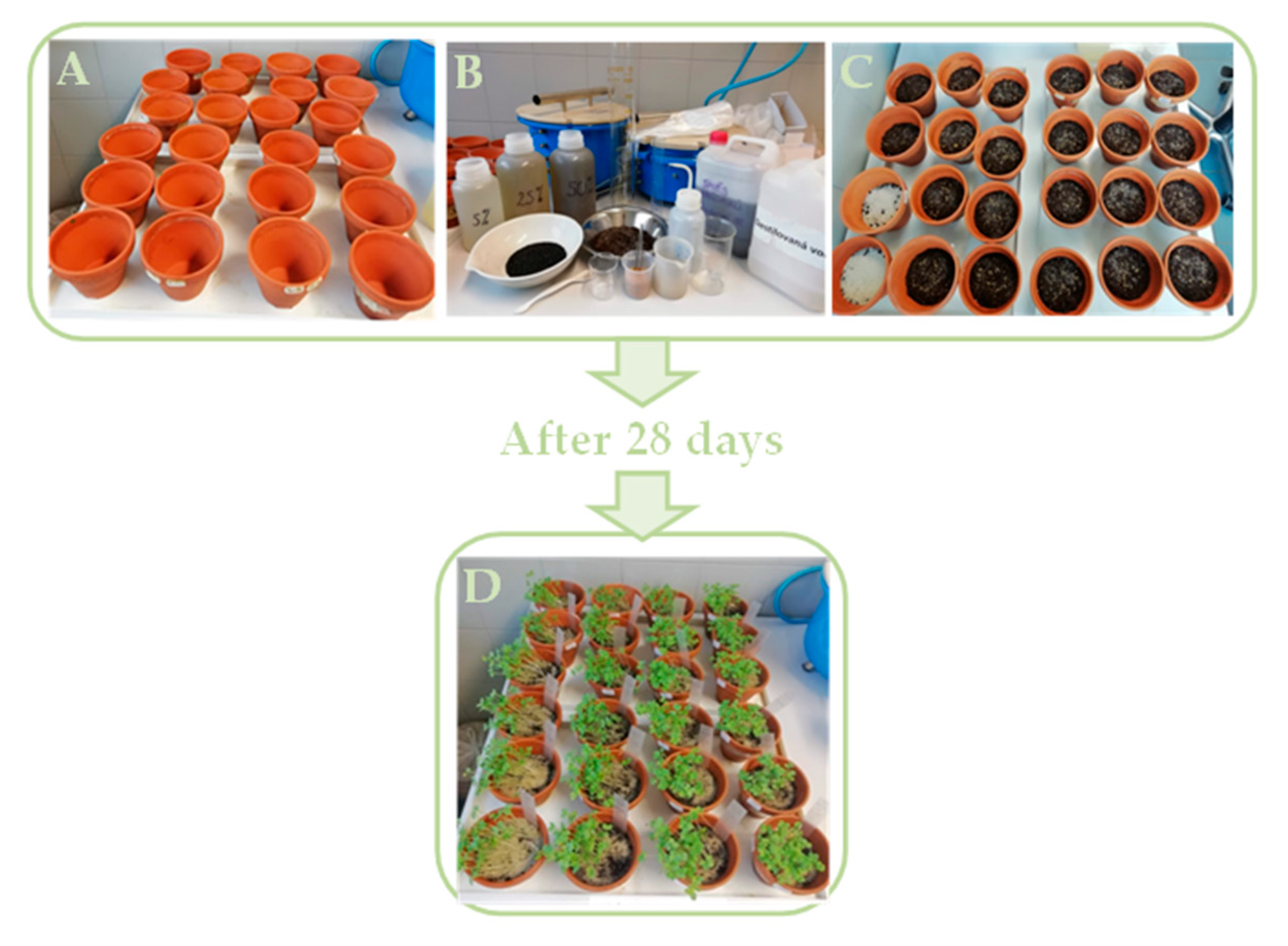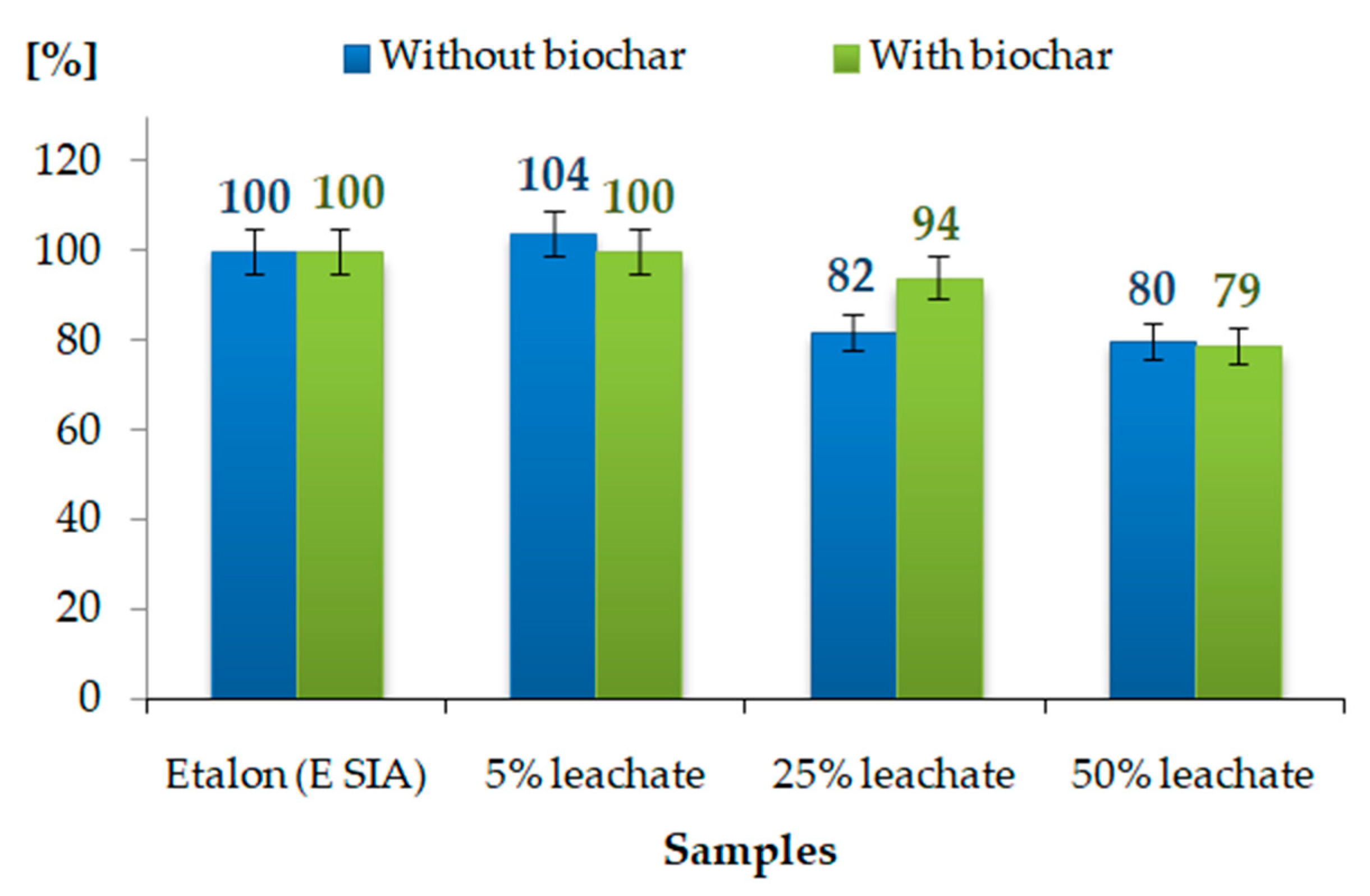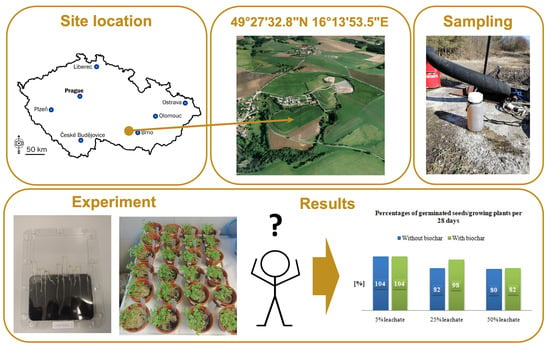Evaluation of the Phytotoxicity of Leachate from a Municipal Solid Waste Landfill: The Case Study of Bukov Landfill
Abstract
:1. Introduction
2. Materials and Methods
2.1. Landfill Site Location
2.2. Physicochemical Analysis of Samples
2.3. Leachate Toxicity with the Use of Microbiotests
2.4. Subchronic Toxicity Pot Experiment
3. Results
3.1. Results of Phytotoxicity Tests
3.2. Measurement of Leachate Parameters
3.3. Results of Subchronic Toxicity Pot Experiment
4. Discussion
4.1. Phytotoxicity Tests
4.2. Leachate Chemical Properties Measurement
4.3. Subchronic Toxicity Pot Experiment
4.4. Potential Use of Leachate—Fire Prevention
5. Conclusions
Author Contributions
Funding
Conflicts of Interest
Appendix A
| Waste Type Code | Name of the Type of Waste | Waste Category |
| 02 01 03 | Plant-tissue waste | O |
| 07 | Wastes form organic chemical processes | |
| 07 02 13 | Waste plastic | O |
| 08 | Wastes from the manufacture, formulation, supply and use (MSFU) of coating (paints, varnishes and vitreous enamels), adhesives, sealants and printing inks | |
| 08 01 12 | Waste paint and varnish other than those mentioned in 08 01 11 | O |
| 08 01 18 | Wastes from paint or varnish removal other than those mentioned in 08 01 17 | O |
| 08 04 10 | Waste adhesives and sealants other than those mentioned in 08 04 09 | O |
| 09 | Wastes from the photographic industry | |
| 09 01 08 | Photographic film and paper free of silver or silver compounds | O |
| 10 | Wastes from thermal processes | |
| 10 01 | Wastes from power stations and other combustion plants (except 19) | |
| 10 01 02 | Coal fly ash | O |
| 10 01 03 | Fly ash from peat and untreated wood | O |
| 10 01 15 | Bottom ash, slag and boiler dust from co-incineration other than those mentioned in 10 0114 | O |
| 10 02 01 | Wastes from the processing of slag | O |
| 10 02 02 | Unprocessed slag | O |
| 10 09 03 | Furnace slag | O |
| 10 09 06 | Casting cores and molds which have not undergone pouring other than those mentioned in10 09 05 | O |
| 10 09 08 | Casting cores and molds have undergone pouring other than those mentioned in 10 09 07 | O |
| 10 11 03 | Waste basing in glass fibers | O |
| 12 | Wastes from shaping and physical and mechanical surface treatment of metals and plastics | |
| 12 01 05 | Plastics shavings and turnings | O |
| 12 01 17 | Waste blasting material other than those mentioned in 12 01 16 | O |
| 12 01 21 | Spent grinding bodies and grinding materials other than those mentioned in 12 01 20 | O |
| 15 | Waste packaging, absorbents, wiping cloths, filter materials and protective clothing not otherwise specified | |
| 15 01 02 | Plastic packaging | O |
| 15 01 05 | Composite packaging | O |
| 15 01 06 | Mixed packaging | O |
| 15 01 07 | Glass packaging | O |
| 15 01 09 | Textile packaging | O |
| 16 | Wastes not otherwise specified in the list | |
| 16 01 19 | Plastic | O |
| 16 01 20 | glass | O |
| 16 03 04 | inorganic wastes other than those mentioned in 16 03 03 | O |
| 16 03 06 | organic wastes other than those mentioned in 16 03 05 | O |
| 16 11 04 | other linings and refractories from metallurgical processes other than those mentioned in16 11 03 | O |
| 17 | Construction and demolition wastes (including excavated oil from contaminated sites) | |
| 17 01 01 | Concrete | O |
| 17 01 02 | Bricks | O |
| 17 01 03 | Tiles and ceramics | O |
| 17 01 07 | Mixture of concrete, bricks, tiles and ceramics other than those mentioned in 17 01 06 | O |
| 17 02 02 | Glass | O |
| 17 02 03 | Plastic | O |
| 17 03 02 | Bituminous mixtures containing other than those mentioned in 17 03 01 | O |
| 17 05 04 | Soil and stones other than those mentioned in 17 05 03 | O |
| 17 05 06 | Dredging spoil other than those mentioned 17 05 05 | O |
| 17 05 08 | Track ballast other than those mentioned in 17 05 07 | O |
| 17 06 04 | Insulation materials other than those mentioned in 17 06 01 and 17 06 03 | O |
| 17 09 04 | Mixed construction and demolition wastes other than those mentioned in 17 09 01, 17 0902 and 17 09 03 | O |
| 18 | Wastes from human or animal health care and/or related research (except kitchen and restaurant wastes not arising from immediate health care) | |
| 18 01 04 | Wastes whose collection and disposal is not subject to special requirements in order to prevent infection (for example dressings, plaster casts, linen, disposable clothing, diapers) | O |
| 19 | Wastes from waste management facilities, off-site wastewater treatment plants and the preparation of water intended for human consumption and water for industrial use | |
| 19 05 01 | Non-composted fraction of municipal and similar wastes | O |
| 19 05 03 | Off-specification compost | O |
| 19 08 01 | Screenings | O |
| 19 08 02 | Waste from desanding | O |
| 19 09 02 | Sludges from water clarification | O |
| 19 09 04 | Spent activated carbon | O |
| 19 09 0519 12 04 | Saturated or spent ion exchange resinsPlastic and rubber | O |
| 20 | Municipal wastes (household waste and similar commercial, industrial and institutional wastes) including separately collected fractions | |
| 20 01 02 | Glass | O |
| 20 01 39 | Plastics | O |
| 20 02 02 | Soil and stones | O |
| 20 02 03 | Other non-biodegradable wastes | O |
| 20 03 01 | Mixed municipal waste | O |
| 20 03 02 | Waste from markets | O |
| 20 03 03 | Street-cleaning residues | O |
| 20 03 06 | Waste from sewage cleaning | O |
| 20 03 07 | Bulky waste | O |
| The list of received waste also includes usable waste (packaging, glass, plastics). These wastes are accepted at the landfill only if they are wastes that cannot be used materially or energetically and this will be documented by a declaration from the producer. 20 03 02-waste from marketplaces is classified according to Decree 341/2008 Coll. as biodegradable waste. It is accepted for landfill only if the share of biodegradable matter is less than 35%. | ||
References
- Krzykawska, K. A landfill peninsula as an experimental use space. A case study of Albany Bulb. Acta Sci. Pol. Archit. 2019, 18, 51–60. [Google Scholar] [CrossRef]
- Adamcová, D. Comparison of technical methods of securing closed landfills in the Czech Republic and Poland. Acta Sci. Pol. Archit. 2019, 18, 61–71. [Google Scholar] [CrossRef]
- Remmas, N.; Roukouni, C.; Ntougias, S. Bacterial community structure and prevalence of Pusillimonas-like bacteria in aged landfill leachate. Environ. Sci. Pollut. 2017, 111, 6757–6769. [Google Scholar] [CrossRef] [PubMed]
- Wong, M.H.; Chan, Y.S.G.; Zhang, C.; Wang-Wai, C. Comparison of pioneer and native woodland species growing on top of an engineered landfill, Hong Kong: Restoration programme. Land Degrad. Dev. 2015, 27, 500–510. [Google Scholar] [CrossRef]
- Kumari, M.; Ghosh, P.; Thakur, I.S. Landfill leachate treatment using bacto-algal co-culture: An integrated approach using chemical analyses and toxicological assessment. Ecotoxicol. Environ. Saf. 2016, 128, 44–51. [Google Scholar] [CrossRef]
- Hu, L.; Du, Y.; Long, Y. Relationship between H2S emissions and migration of sulfur–contanning compounds in landfill. Ecol. Eng. 2017, 106, 17–23. [Google Scholar] [CrossRef]
- Koda, E.; Osinski, P.; Kolanka, T. Flow numerical modeling for efficiency assessment of vertical barriers in landfills. In Coupled Phenomena in Environmental Geotechnics: From Theoretical and Experimental Research to Practical Applications, Proceedings of the Conference: International Symposium of the International-Society-for-Soil-Mechanics-and-Geotechnical-Engineering (ISSMGE), Torino, Italy, 1–3 July 2013; CRC Press: London, UK, 2013; pp. 693–698. [Google Scholar]
- Vaverková, M.D.; Adamcová, D. Long-Term Temperature Monitoring of a Municipal Solid Waste Landfill. Pol. J. Environ. Stud. 2015, 24, 1373–1378. [Google Scholar] [CrossRef]
- Wang, X.; Cao, A.; Zhao, G.; Zhou, C.; Xu, R. Microbial community structure and diversity in a municipal solid waste landfill. Waste Manag. 2017, 66, 79–87. [Google Scholar] [CrossRef]
- Samadder, S.R.; Prabhakar, R.; Khan, D.; Kishan, D.; Chauhan, M.S. Analysis of the contaminants released from municipal solid waste landfill site: A case study. Sci. Total Environ. 2017, 580, 593–601. [Google Scholar] [CrossRef]
- Ghosh, P.; Thakur, I.S.; Kaushik, A. Bioassays for toxicological risk assessment of landfill leachate: A review. Ecotoxicol. Environ. Saf. 2017, 141, 259–270. [Google Scholar] [CrossRef]
- Zhao, R.; Xi, B.; Liu, Y.; Su, J.; Liu, S. Economic potential of leachate evaporation by using landfill gas: A system dynamics approach. Resour. Conserv. Recycl. 2017, 124, 74–84. [Google Scholar] [CrossRef]
- Arunbabu, V.; Indu, K.S.; Ramasamy, E.V. Leachate pollution index as an effective tool in determining the phytotoxicity of municipal solid wasteleachate. Waste Manag. 2017, 68, 329–336. [Google Scholar] [CrossRef] [PubMed]
- Baderna, D.; Caloni, F.; Benfenati, E. Investigating landfill leachate toxicity in vitro: A review of cell models and endpoints. Environ. Int. 2019, 122, 21–30. [Google Scholar] [CrossRef] [PubMed]
- Benfenati, E.; Maggioni, S.; Campagnola, G.; Senese, V.; Lodi, M.; Testa, S.; Schramm, K.W. A Protocol to Evaluate Organic Compounds Present in a Landfill; Velinni, A.A., Ed.; Landfill Research Trends-Nova Science: Huntington, NY, USA, 2007; pp. 141–166. [Google Scholar]
- Ribé, V.; Nehrenheim, E.; Odlare, M.; Gustavsson, L.; Berglind, R.; Forsberg, Å. Ecotoxicological assessment and evaluation of a pine bark biosorbent treatment of five landfill leachates. Waste Manag. 2012, 32, 1886–1894. [Google Scholar] [CrossRef]
- Ignatius, A.; Arunbabu, V.; Neethu, J.; Ramasamy, E.V. Rhizo filtration of lead using an aromatic medicinal plant Plectranthus amboinicus cultured in a hydroponic nutrient film technique (NFT) system. Environ. Sci. Pollut. Res. Int. 2014, 21, 13007–13016. [Google Scholar] [CrossRef]
- Kalčíková, G.; Zagorc-Končan, J.; Zupančič, M.; Gotvajn, A.Ž. Variation of landfill leachate phytotoxicity due to landfill ageing. J. Chem. Technol. Biotechnol. 2012, 87, 1349–1353. [Google Scholar] [CrossRef]
- Mohamed, B.A.; Ellis, N.; Kim, C.S.; Bi, X. The role of tailored biochar in increasing plant growth, and reducing bioavailability, phytotoxicity, and uptake of heavy metals in contaminated soil. Environ. Pollut. 2017, 230, 329–338. [Google Scholar] [CrossRef]
- IRS Services, Towards Improved Fire Management in Landfill Sites, July 2012. Available online: https://files-em.em.vic.gov.au/public/EMV-web/Fire_Management.pdf (accessed on 22 October 2020).
- Cui, H.Y.; Zhao, Y.; Chen, Y.N.; Zhang, X.; Wang, X.Q.; Lu, Q.; Jia, L.M.; Wei, Z.M. Assessment of phytotoxicity grade during composting based on EEM/PARAFAC combined with projection pursuit regression. J. Hazard. Mater. 2017, 326, 10–17. [Google Scholar] [CrossRef]
- Vaverková, M.D.; Zloch, J.; Adamcová, D.; Radziemska, M.; Vyhnánek, T.; Trojan, V.; Winkler, J.; Đordević, B.; Elbl, J.; Brtnický, M. Landfill Leachate Effects on Germination and Seedling Growth of Hemp Cultivars (Cannabis Sativa L.). Waste Biomass Valorization 2019, 10, 369–376. [Google Scholar] [CrossRef]
- Song, B.; Zeng, G.; Gong, J.; Zhang, P.; Deng, J.; Deng, C.; Yan, J.; Xu, P.; Lai, C.; Zhang, C.; et al. Effect of multi-walled carbon nanotubes on phytotoxicity of sediments contaminated by phenanthrene and cadmium. Chemosphere 2017, 172, 449–458. [Google Scholar] [CrossRef]
- Maiorana, S.; Teoldi, F.; Silvani, S.; Mancini, A.; Sanguineti, A.; Mariani, F.; Cella, C.; Lopez, A.; Potenza, M.A.C.; Lodi, M.; et al. Phytotoxicity of weat debris from traditional and innovative brake pads. Environ. Int. 2019, 123, 156–163. [Google Scholar] [CrossRef] [PubMed]
- Tomanová, L. Operating rules of MSW landfill Bukov. Dolní Rožínka (CZE) 2017, 57, 11–50. (In Czech) [Google Scholar]
- Šourková, M. Evaluation of the Phytotoxicity of Leachate from Municipal Solid Waste Landfill Bukov. Master´s Thesis, Mendel Univerzity in Brno, Faculty of AgriSciences, Brno, Czech Republic, 2019. (In Czech). Available online: https://theses.cz/id/nwv7x9/ (accessed on 26 July 2020).
- Štěpánek, M.; (MSW landfill Bukov, Bukov, Czech Republic). Personal communication, 2018. (In Czech).
- MicroBioTests Inc. Phytotoxkit. Seed Germination and Early Growth Microbiotest with Higher Plants. Standard Operation Procedure, Nazareth, Belgium. 2004. Available online: https://www.microbiotests.com/wp-content/uploads/2019/05/Phytotoxicity-test_Phytotoxkit-solid-samples_Standard-Operating-Procedure.pdf (accessed on 5 May 2020).
- Čabala, R. Ecotoxicology: The Boundary between Ecology and Toxicology? Lecture 2015. (In Czech). Available online: https://www.natur.cuni.cz/chemie/analchem/cabala/ke-stazeni/ekotoxikologie/soubor-prednasek-z-ekotoxikologie-zs2013/prednaska-1/view (accessed on 26 July 2020).
- Hamplova, V. The Study of Wastewater Toxicity Using Selected Acute and Semichronic Ecotoxicity Tests. Master´s Thesis, VŠB—Technical University of Ostrava, Faculty of Mining and Geology, Ostrava, Czech Republic, 2017. (In Czech). Available online: https://dspace.vsb.cz/bitstream/handle/10084/119988/HAM0049_HGF_N2102_2102T006_2017.pdf?sequence=1 (accessed on 14 June 2020).
- Zloch, J.; Vaverková, M.D.; Adamcová, D.; Radziemska, M.; Vyhnálek, T.; Trojan, V.; Đordević, B.; Brtnický, M. Seasonal Changes and Toxic Potency of Landfill Leachate for White Mustard (Sinapis alba L.). Acta Univ. Agric. Silvic. Mendel. Brun. 2018, 66, 235–242. [Google Scholar] [CrossRef] [Green Version]
- Vaverková, M.D.; Adamcová, D.; Zloch, J.; Radziemska, M.; Radziemska, M.; Boas-Berg, A.; Voběrková, S.; Maxiánová, A. Impact of Municipal Solid Waste Landfill on Environment—A Case Study. J. Ecol. Eng. 2018, 19, 55–68. [Google Scholar] [CrossRef]
- The Standard EN 13432:2000. Annex E: Determination of Ecotoxic Effect on Higher Plants; Office for Technical Standardization, Metrology and State Testing: Prague, Czech Republic, September 2001; p. 22, Classification Mark 77 0153. (In Czech)
- Baran, A.; Tarnawski, M. Phytotoxkit/Phytoteskit and Microtox® as tools for toxicity assessment of sediments. Ecotoxicol. Environ. Saf. 2013, 98, 19–27. [Google Scholar] [CrossRef]
- Vaverková, M.D. Impact assessment of the municipal solid landfill on environment: A case study. Acta Sci. Pol. Archit. 2019, 18, 11–20. [Google Scholar] [CrossRef]
- Angaye, T.C.N.; Seiyaboh, E.I.; Wu, W. Ecotoxicological Assessment of Leachate from Municipal Solid Waste Dumpsites. J. Exp. Clin. Toxicol. 2019, 1, 31–40. [Google Scholar] [CrossRef] [Green Version]
- Gu, Z.; Chen, W.; Wang, F.; Li, Q. A pilot-scale comparative study of bioreactor landfills for leachate decontamination and municipal solid waste stabilization. Waste Manag. 2020, 103, 113–121. [Google Scholar] [CrossRef]
- Somani, M.; Datta, M.; Gupta, S.K.; Sreekrushnan, T.R.; Ramana, G.V. Comprehensive assessment of the leachate quality and its pollution potential from six municipal waste dumpsites of India. Bioresour. Technol. Rep. 2019, 6, 198–206. [Google Scholar] [CrossRef]
- Rong, L. Management of Lanadfill Leachate. Final Thesis, Tampere University of Applied Sciences, Degree Programme of Environmental Engineering. 2009. Available online: https://www.theseus.fi/bitstream/handle/10024/8413/Rong.Li.pdf (accessed on 12 August 2020).
- Smith, B. Water Characteristics of Landfill Leachate in Uusikaupunki. Bachelor’s Thesis, Tampere University of Applied Sciences, Energy and Environmental Engineering, Tampere, Finland, 2020. Available online: https://www.theseus.fi/bitstream/handle/10024/333806/Smith_Braden.pdf?sequence=3&isAllowed=y (accessed on 8 April 2020).
- Ragazzi, M. Sewage and Landfill Leachate: Assessment and Remediation of Environmental Hazards, 1st ed.; Apple Academic Press: Oakville, ON, Canada, 2016; p. 6. [Google Scholar]
- Westlake, K. Landfill Waste Pollution and Control, 1st ed.; Albion Publishing: Harrogate, UK, 1995; pp. 1–2. [Google Scholar]
- Umar, M.; Aziz, H.A.; Yusoff, M.S. Variability of Parameters Involved in Leachate Pollution Index and Determination of LPI from Four Landfills in Malaysia. Int. J. Chem. Eng. 2010, 2010, 747953. [Google Scholar] [CrossRef]
- Gupta, A.; Paulraj, R. Leachate composition and toxicity assessment: An integrated approach correlating physicochemical parameters and toxicity of leachates from MSW landfill in Delhi. Environ. Technol. 2017, 38, 1599–1605. [Google Scholar] [CrossRef] [PubMed]
- Mishra, H.; Karmakar, S.; Kumar, R.; Singh, J. A Framework for Assessing Uncertainty Associated with Human Health Risks from MSW Landfill Leachate Contamination. Risk Anal. 2017, 37, 1237–1255. [Google Scholar] [CrossRef] [PubMed]
- Guerrero-Rodríguez, D.; Sánchez-Yáñez, J.M.; Buenrostro-Delgado, O.; Márquez-Benavides, L. Phytotoxic Effect of Landfill Leachate with Different Pollution Indexes on Common Bean: A case study. Acta Sci. Pol. Archit. 2014, 225, 11–20. [Google Scholar] [CrossRef]
- Gupta, A.; Rajamani, P.; Ramasamy, E.V.; Márquez-Benavides, L. Toxicity Assessment of Municipal Solid Waste Landfill Leachate Collected in Different Seasons from Okhala Landfill Site of Delhi: A case study. J. Biomed. Eng. 2015, 8, 357–369. [Google Scholar] [CrossRef] [Green Version]
- U.S. Fire Administration. Landfill Fires. Topical Fire Research Series, March 2001. Available online: https://nfa.usfa.fema.gov/downloads/pdf/statistics/v1i18-508.pdf (accessed on 1 November 2020).






| A Measured Parameter with Units | Value Measurement (Month/Year) | Value Measurement (Month/Year) |
|---|---|---|
| pH | 7.1 | 8.3 |
| 08/2012 | 04/2013 | |
| LDO (mg/L) | 6000 | 2000 |
| 01/2012 | 08/2013 | |
| CDC (µS/cm) | 27 | 5 |
| 05/2013 | 09/2012 |
Publisher’s Note: MDPI stays neutral with regard to jurisdictional claims in published maps and institutional affiliations. |
© 2020 by the authors. Licensee MDPI, Basel, Switzerland. This article is an open access article distributed under the terms and conditions of the Creative Commons Attribution (CC BY) license (http://creativecommons.org/licenses/by/4.0/).
Share and Cite
Šourková, M.; Adamcová, D.; Zloch, J.; Skutnik, Z.; Vaverková, M.D. Evaluation of the Phytotoxicity of Leachate from a Municipal Solid Waste Landfill: The Case Study of Bukov Landfill. Environments 2020, 7, 111. https://0-doi-org.brum.beds.ac.uk/10.3390/environments7120111
Šourková M, Adamcová D, Zloch J, Skutnik Z, Vaverková MD. Evaluation of the Phytotoxicity of Leachate from a Municipal Solid Waste Landfill: The Case Study of Bukov Landfill. Environments. 2020; 7(12):111. https://0-doi-org.brum.beds.ac.uk/10.3390/environments7120111
Chicago/Turabian StyleŠourková, Markéta, Dana Adamcová, Jan Zloch, Zdzisław Skutnik, and Magdalena Daria Vaverková. 2020. "Evaluation of the Phytotoxicity of Leachate from a Municipal Solid Waste Landfill: The Case Study of Bukov Landfill" Environments 7, no. 12: 111. https://0-doi-org.brum.beds.ac.uk/10.3390/environments7120111







